Seven books for those who want to become a game designer

This article talks about when and how game design became a profession, as well as how it formed into a separate discipline. We also offer 7 books to read for every game designer. We will explain what is especially valuable in these books and how they will allow you to become a professional game designer. There are other articles with recommendations for books on game design, but their authors do not indicate the specific order in which they are read. We listed books in a specific order, allowing the reader to smoothly improve their game design skills. Moreover, the article describes in detail the order and reasons for studying these books.
This article is not marketing the materials described, but provides information on where and what to learn.
Introduction
Humanity has been playing games for thousands of years. We play some of them today (see table 1). Not only for humans, but for many animals, play is a critical form of self-development. The game teaches vital skills for their future lives [1].
Table 1: games played for thousands of years
| Games | date |
|---|---|
| Hunting games | from time immemorial |
| Royal game of ur | More than 4500 years |
| Olympic Games | 2800 years |
| Go | 2500 years |
| Chess | 1500 years |
But when did game development turn into a profession? How much knowledge and skills have we accumulated at the moment? How mature is our knowledge?
In this article, you will learn how game design has become a profession. And if we want to create games, then
- what we need to learn
- what sources to study?
Game design as a profession
In the 1950s, as a result of purely scientific research, video games appeared. Soon, in 1971, the first arcade games (Galaxy Game, Computer Space) were created. In 1972, the first Magnavox Odyssey video game console was released, allowing you to play video games at home. 1978 is considered the beginning of the Golden Age of arcade video games. [2]
So, in the early 70's, people started making money by making games. Creating games began to be profitable, and therefore companies needed more professionals who could make them. That is, the profession of a game designer appeared about 50 years ago.
(As Scott Rogers mentioned in the comments, “people have been earning game design since 1883,” but then the game market was not yet formed, in which a significant number of professionals could work as game developers.)
Over time, new platforms appeared, technologies were developed, and game developers became more and more people. Naturally, it was important for specialists to know why some games are more fun than others. How to make better games? In trying to answer this question, we have accumulated enough knowledge so that we can talk about game design not just as a profession, but also as a separate discipline. Figure 1 shows the important milestones that influenced the development of game design as a separate discipline.
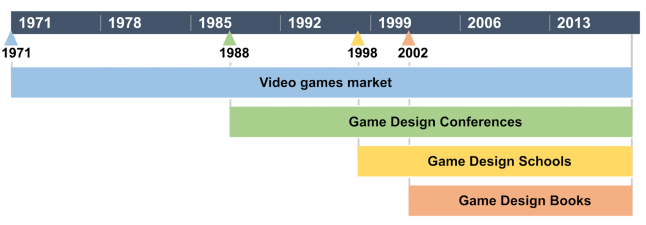
Figure 1. Game design is becoming a separate discipline.
Some timeline data:
- The first GDC game development conference was organized by Chris Crawford in 1988 in his living room. It was attended by only 27 game designers. The second conference, held in the same year, attracted the attention of approximately 125 specialists. [3]
- Game design schools where you can get a degree in game design:
| Game Design Degree Date | Institution |
|---|---|
| 1998 | DigiPen Institute of Technology [4] |
| 2002 | School of Cinematic Arts at the University of Southern California [5] |
| 2007 | Rochester Institute of Technology (the first game development courses appeared in 2001) |
| 2018 | University of Utah's Entertainment Arts and Engineering Program (Since 2009, the University of Utah has a game design program as part of a degree in cinematography and computer science [6]) |
- Game design books and time of first publication:
| First edition | Game Design Book and Author |
|---|---|
| 2002 | The Art of Interactive Design by Chris Crawford |
| 2003 | Chris Crawford on Game Design by Chris Crawford |
| 2003 | Rules of Play: Game Design Fundamentals by Katie Salen, Eric Zimmerman |
| 2004 | Chris Crawford on Interactive Storytelling by Chris Crawford |
| 2004 | Game Design Workshop: A Playcentric Approach to Creating Innovative Games by Tracy Fullerton |
| 2004 | A Theory of Fun for Game Design by Raph Koster |
| 2006 | Fundamentals of Game Design by Ernest Adams |
| 2008 | Game Feel: A Game Designer's Guide to Virtual Sensation by Steve Swink |
| 2008 | The Art of Game Design: A Book of Lenses by Jesse Schell |
Someone may say that schools of game design existed in the world even before 1998 (for example, the LED school in Osaka in 1986 [7]). Or that the first book about game design was not written in 2002, but much earlier (for example, The Art of Computer Game Design by Chris Crawford, whose first edition appeared in 1984). But these are more likely exceptions than rules. The timeline shows periods when a significant number of books have been released or a significant number of institutions offering degree in game design have appeared.
Looking at Figure 1 , one can understand that structured knowledge and sources, for example, educational institutions and literature, appeared in the early 2000s. That is, game design as a discipline originated in the early 2000s and is only 20 years old.
This in turn means that a considerable amount of knowledge and experience has been accumulated, therefore this structured knowledge should be studied. The essence of cultural evolution is that we do not need to rediscover everything from scratch; we learn from the experience of others, after which we study and invent ourselves. In the end, if you want to become a doctor, artist, physicist, engineer, musician or cinematographer, then you first study what is already known, and then try to expand the boundaries of knowledge. Some ingenious game designers, for example
- Shigeru Miyamoto (studied industrial design)
- Will Wright (studied architecture, mechanical engineering),
- Sid Meyer (studied computer science),
- Hideo Kojima (studied economics)
created many great games without any formal training in game design. However, it would be erroneous to believe that education in game design is futile. Explore modern opportunities that were not available to these designers [8].
On the other hand, it is important to say that teaching on teaching materials is only one side of the coin - theory. Of course, it is necessary to combine theory and practice. By playing, analyzing both good and bad games, as well as creating your own, you will find out the other side. And for a game designer, both of these activities should become part of everyday life.
7 must-read books on game design
Now let's talk about the compulsory study books that I have chosen for this article. Books are ordered by increasing difficulty, i.e. the first books are good for beginners, and the next ones give more complex or auxiliary content.
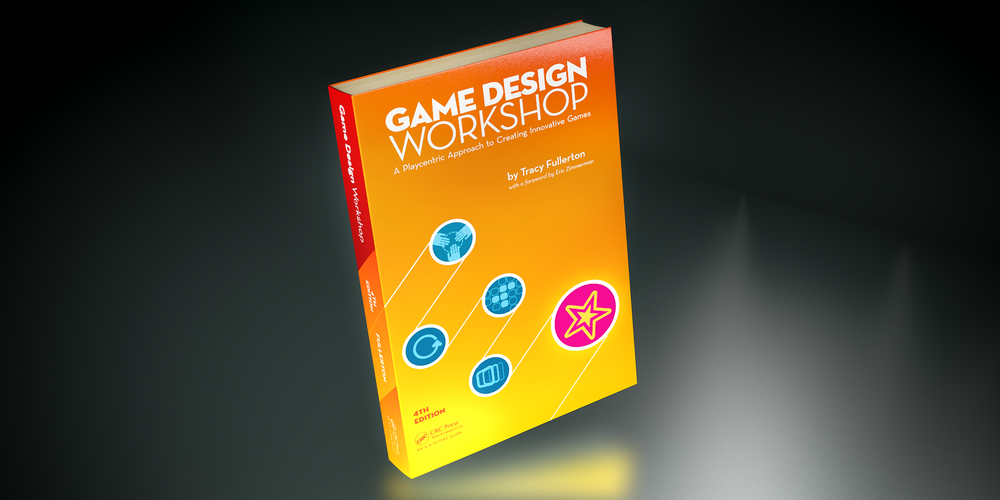
1) Game Design Workshop: A Playcentric Approach to Creating Innovative Games by Tracy Fullerton
Recommended for beginner and intermediate levels.
There are two reasons why you should start learning game design with this book. The author, Tracy Fullerton, is a professor at the USC Interactive Media & Games Division, and as you read the book, you feel like it's a textbook written for her students. The book is written in a very accessible language, well structured and covers the most important topics needed by the game designer. It reveals everything: the professional responsibilities of a game designer, the stage of origin of the idea of a game, prototyping, balancing, work as a game designer, and much more. From this book you will learn the following:
- Formal elements. These are the elements that create the structure of the game, without them it does not exist.
- Dramatic elements. These are elements that set the context of gameplay and enthrall the player emotionally.
- Proper prototyping of the game
- Playtesting games and analyzing test results
- How to work as a game designer.
Also in this book are extremely valuable special chapters called Designer Perspective . These are chapters of several pages that introduce the reader to different designers, their work and tips. You will notice that each game designer has something unique, but at the same time, they have common characteristics for everyone. In addition, you will understand what it means to be a game designer. Also in the book there are many references to other books, games and articles for further study.
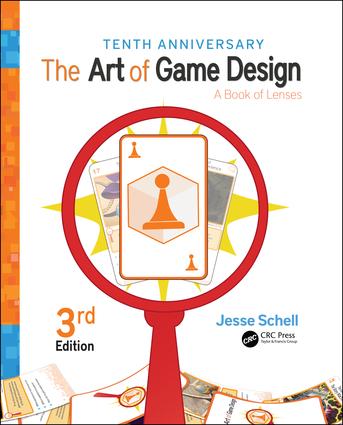
2) The Art of Game Design: A Book of Lenses by Jesse Schell
Recommended for beginner and intermediate levels.
[An unofficial translation entitled “The Art of Game Design” can be found on the Internet]
This book is very similar to the first in that it can also be used as a textbook: it also covers almost all topics that a game designer should understand. This book is also very well structured and easy to understand, with very rich content, nevertheless accessible to beginners. Curiously, this book gives the reader 113 “lenses” (lens). Each magnifier is a unique point of view on one specific aspect of the game. In each loop there are several questions that you need to ask yourself in order to understand whether your game matches this loop and how to improve the game in this particular aspect. For example, Magnifier 40 (one of my favorites) is called the Triangle Magnifier (see Figure 2 ). Almost every good game has a triangle, which in essence is a balance between risk and reward, giving the player a choice - take a chance to get a bigger reward, or protect yourself by choosing a smaller one.

Figure 2: Triangle Magnifier
By the way, the magnifiers presented in the book are also collected in a deck, which is sold separately. It is called “The Art of Game Design: A Deck of Lenses” ( Figure 2 shows one of the lenses on the deck).
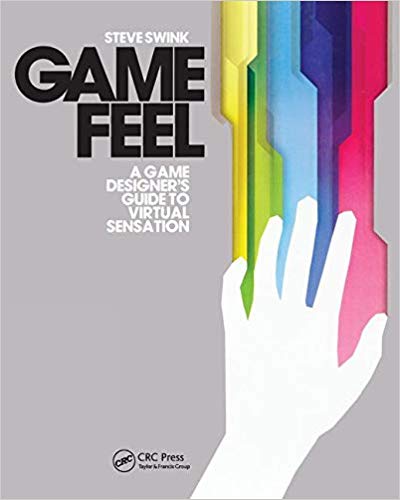
3) Game Feel: A Game Designer's Guide to Virtual Sensation by Steve Swink
Recommended for medium and high levels.
After reading the two magnificent books mentioned above, you can get down to more complex information. Game Feel is an outstanding book, and not one book contains the information contained in it. In fact, this book explains how the feeling of the game is formed in the process of interacting with it. It explains why the two games may seem very similar, but one feels good and the other feels bad. From the book you will learn the following:
- how human perception works
- about the three building blocks of the sensations of the game (real-time control, sophistication and simulated space)
- about six metrics of sensations from the game (input, reaction, context, refinement, metaphor, rules)
The book understands several well-known games and, based on these metrics, explains why these games seem good. This book is an excellent work exploring perception and how games are felt to be good.
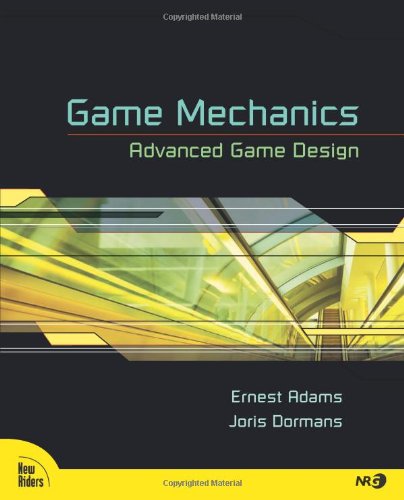
4) Game Mechanics: Advanced Game Design by Ernest Adams and Joris Dormans
Recommended for medium and high levels.
This is also an outstanding book of a more complex level, although very different from the previous one. This game divides games into two types - games of emerging properties (emergence) and games of development. The book describes well aspects of both types of game design, but it mainly focuses on emergent games. These are games with relatively simple rules, but with more variability and more difficulties; the development of events in them is not planned in advance, but arises during the game. Chess, go, SimCity, The Sims, Sid Meier's Civilization and so on are good examples of such games.
- The key idea of the book is that the outcome of the game should be unpredictable. There are three ways to implement this:
- by chance (for example, rolls of dice or spinning roulette in a board game)
- the choices made by the players (example: any multiplayer game)
- complex gameplay created by the rules of the game (example: chess)
- The main theme of this book is the complex gameplay created by the rules of the game. The book explains that if we can create such game mechanics so that the game turns into emergent, then it becomes interesting and replayable simply thanks to the mechanics (and not because of its aesthetics or plot).
- The book presents 16 design patterns of game mechanics that can be used to create an emergent game.
- It also describes a game design tool called “Machinations framework” created by Joris Dormans. The book explains how to use Machinations to model the mechanics of a game and learn how its internal economy works. The free beta of the Machinations framework can be downloaded here: machinations.io . While reading a book, you will need to study and apply this tool to understand the contents of the book.
“Game Mechanics: Advanced Game Design” gives you the opportunity to perceive and understand game mechanics in a new way. This is a huge step forward towards abstracting and formalizing the creation, testing and balancing of game mechanics.
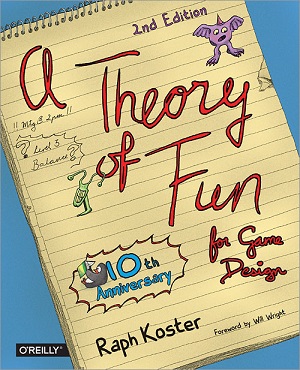
5) A Theory of Fun for Game Design by Raph Koster
Recommended for medium and high levels.
This is a great book by Raf Coster. Reading this book, I was amazed at its uniqueness and strength, as well as the amount of information useful to the game designer. However, I would not call it particularly practical. This book will not give you specific tools that you can apply in your new game, but it will teach you:
- the essence of who a game designer is,
- how the human brain works, who the players are and what they want
- when and why games get boring.
That is, it is more about the philosophy of game design and the psychology of man as a player, and every game designer should know this information. Although it does not give you specific tools, it broadens the view of games. It will help you when creating levels to always provide players with something new and interesting, and so on. Therefore, do not consider this book a pure and useless theory. She will definitely make you a stronger game designer.

6) Level Up! The Guide to Great Video Game Design by Scott Rogers
Recommended as reading aid after books listed.
As the name implies, basically this book is a guide. Its structure is more like a reference. If she talks about a topic, she lists all the possible types on this topic. For example, all possible types of cameras, camera movements, UI elements, all cliched topics of video games, all possible types of enemies, and so on. Because of this, it was honestly difficult for me to read it, but the book has tremendous value. During brainstorming sessions on game design, you will often notice that the ideas that you read about in this book form in your head. That is, it is definitely a book very useful for a game designer, enriching his baggage of gaming concepts. In addition, you will most likely find in it a lot of useful tips on level design, the size of game objects, jump heights and much more.
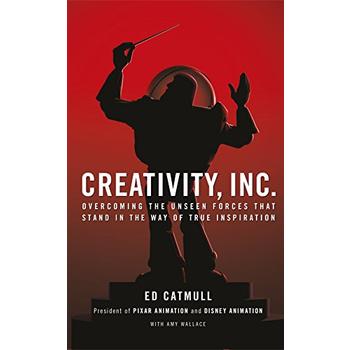
7) Creativity, Inc .: Overcoming the Unseen Forces That Stand in the Way of True Inspiration by Amy Wallace and Edwin Catmull
Recommended as reading aid after books listed.
Ed Catmell is a former president of Pixar and Walt Disney Animation Studios. This book is essentially his biography and the history of Pixar. This is definitely not a game design book. Then why do I think it is a must-read for game designers? Because the development of video games and, in particular, game design is a very creative field. Usually people don’t like boring and routine tasks, but want something more creative. But when they are faced with a creative task, they begin to complain that the task is incomprehensible, and they do not know what exactly needs to be done. And this book is for such situations. She teaches that creativity is the creation of something new and useful. When you do something new, you cannot be sure that you are moving in the right direction. That is, creativity is always accompanied by uncertainty. As a game designer, you need to have your own vision and make decisions in the face of this uncertainty. You must accept this uncertainty and keep moving in the dark. You will learn other important things from this book:
- How to respond to problems
- About turning the original idea into something beautiful and mature at the end of the project
- You must believe that the team has the true power of creativity. And with the right approach, you are able to release this potential or suppress it.
- You will understand that failure is not always bad. If you do something new, you will fail, and more than once. You are protected from failures only when you do it long ago mastered and repeated many times, which has nothing to do with creativity.
This book has many useful tips, inspiring examples of the most successful and creative companies: Lucasfilms, Pixar and Disney. It will give you an understanding of how great products are created, which will be a good addition to your arsenal.
Bonus Material
Recommended for amateurs and professionals.
The 2018 master class at https://www.masterclass.com presents 21 Will Wright video lectures. The master class is called "Will Wright Teaches Game Design And Theory." This video course is a terrific inspirational and informative material, which I recommend to watch not only for professional game designers, but also for all people who love games. Will talks about specific issues he had to deal with while working on The Sims, SimCity, Spore, and many other games. He shares amazing details and shows with concrete examples how a game designer should think, how he should approach problems, and also gives practical tools for solving them.
Finally
Game design is a fairly young discipline, it is only 20 years old. In the future, game designers and game researchers will still invent and learn a lot. Although this discipline is very new, a lot of knowledge has already accumulated in it in the form of books, articles, etc. I have listed 7 required reading books that will allow you to start from scratch and become a game designer - a specialist with an extensive set of tools for analyzing other people's games and creating your own.
I repeat - if you only read, without practice it will improve your skills very little. People learn by doing something (and teaching others). Therefore, you need to gradually apply in your prototypes and games the valuable advice that you learned from books, trying to make each new game at least slightly better than the previous one.
Reference materials
- https://pediatrics.aappublications.org/content/119/1/182?fbclid=IwAR0Xu8aiviBpd9bKaUqi0mMllUcFt7YvoXxpNY9c8EghK8aBLt3A2kW8368
- https://www.bmigaming.com/videogamehistory.htm
- https://en.wikipedia.org/wiki/Game_Developers_Conference
- https://www.digipen.edu/about/our-history
- Game Design Workshop: A Playcentric Approach to Creating Innovative Games, Fourth Edition by Tracy Fullerton
- https://www.gamedesigning.org/schools/utah/
- https://www.kotaku.com.au/2008/01/wanna_study_game_design_in_japan_heres_how-2
- https://www.gamesindustry.biz/articles/2018-12-20-to-be-a-good-game-designer-you-have-to-be-a-good-designer-first
All Articles